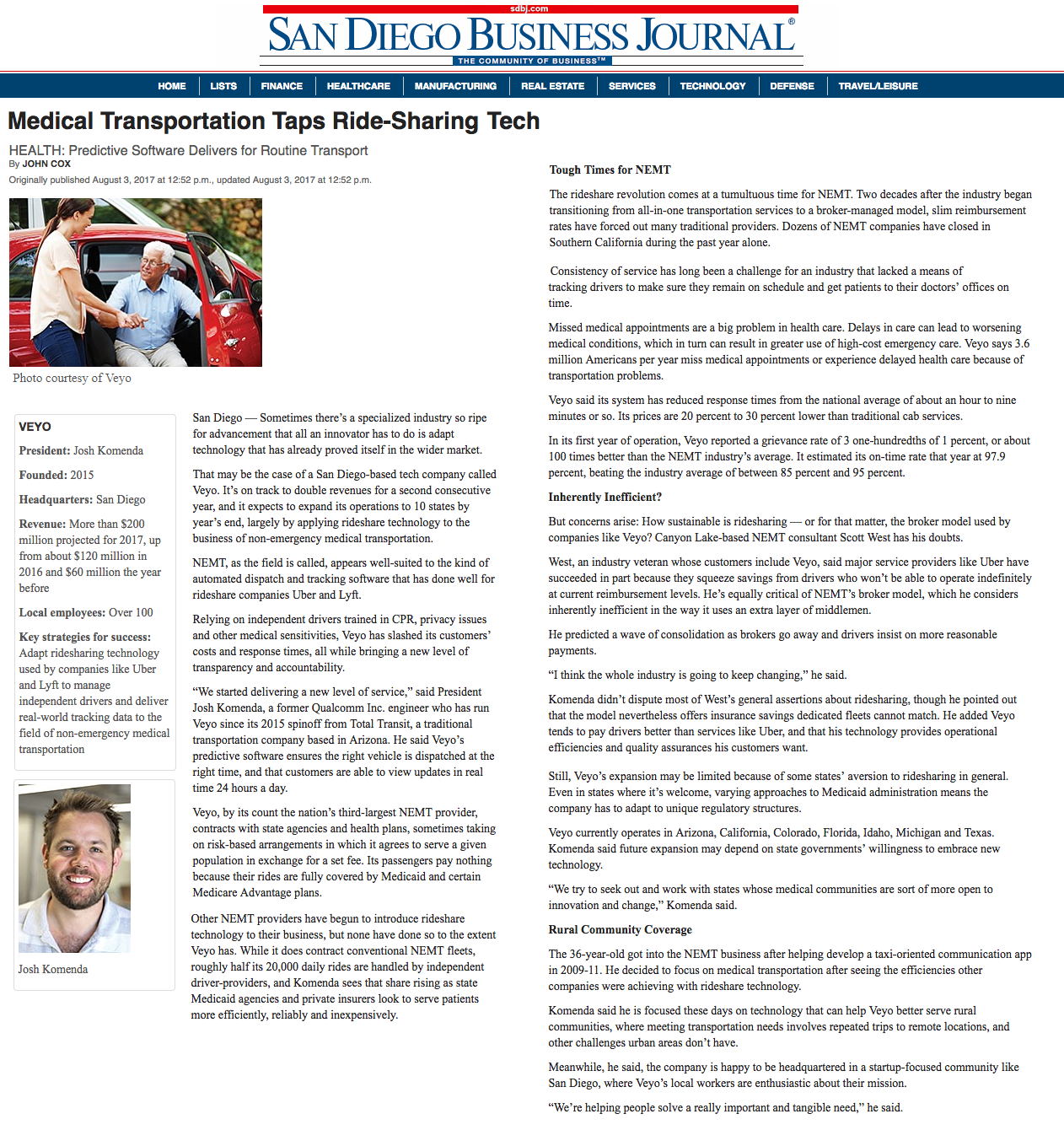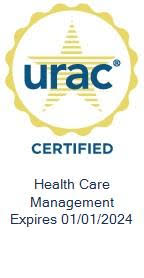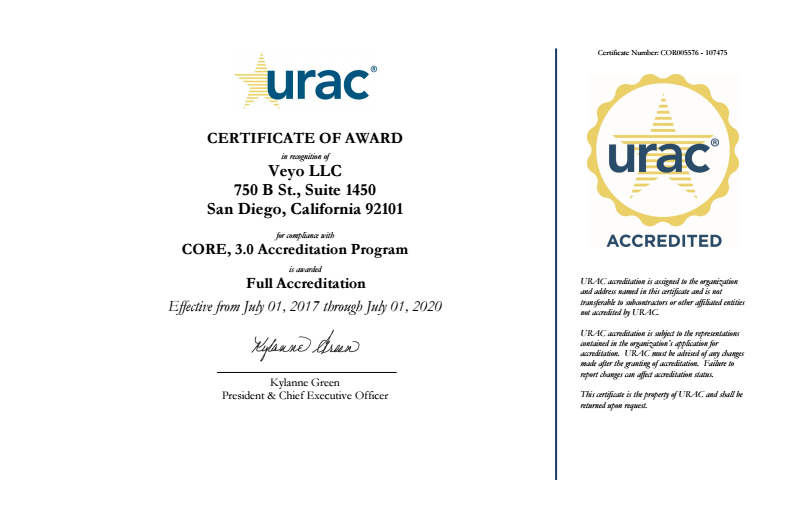Medical Transportation Taps Rideshare Technology
August 3, 2017
Medical Transportation Taps Rideshare Tech – Sometimes there’s a specialized industry so ripe for advancement that all an innovator has to do is adapt technology that has already proved itself in the wider market.
That may be the case of a San Diego-based tech company called Veyo. It’s on track to double revenues for a second consecutive year, and it expects to expand its operations to 10 states by year’s end, largely by applying rideshare technology to the business of non-emergency medical transportation.
NEMT, as the field is called, appears well-suited to the kind of automated dispatch and tracking software that has done well for rideshare companies Uber and Lyft.
Relying on independent drivers trained in CPR, privacy issues and other medical sensitivities, Veyo has slashed its customers’ costs and response times, all while bringing a new level of transparency and accountability.
“We started delivering a new level of service,” said President Josh Komenda, a former Qualcomm Inc. engineer who has run Veyo since its 2015 spinoff from Total Transit, a traditional transportation company based in Arizona. He said Veyo’s predictive software ensures the right vehicle is dispatched at the right time, and that customers are able to view updates in real time 24 hours a day.
Veyo, by its count the nation’s third-largest NEMT provider, contracts with state agencies and health plans, sometimes taking on risk-based arrangements in which it agrees to serve a given population in exchange for a set fee. Its passengers pay nothing because their rides are fully covered by Medicaid and certain Medicare Advantage plans.
Other NEMT providers have begun to introduce rideshare technology to their business, but none have done so to the extent Veyo has. While it does contract conventional NEMT fleets, roughly half its 20,000 daily rides are handled by independent driver-providers, and Komenda sees that share rising as state Medicaid agencies and private insurers look to serve patients more efficiently, reliably and inexpensively.
Tough Times for NEMT
The rideshare revolution comes at a tumultuous time for NEMT. Two decades after the industry began transitioning from all-in-one transportation services to a broker-managed model, slim reimbursement rates have forced out many traditional providers. Dozens of NEMT companies have closed in Southern California during the past year alone.
Consistency of service has long been a challenge for an industry that lacked a means of tracking drivers to make sure they remain on schedule and get patients to their doctors’ offices on time.
Missed medical appointments are a big problem in health care. Delays in care can lead to worsening medical conditions, which in turn can result in greater use of high-cost emergency care. Veyo says 3.6 million Americans per year miss medical appointments or experience delayed health care because of transportation problems.
Veyo said its system has reduced response times from the national average of about an hour to nine minutes or so. Its prices are 20 percent to 30 percent lower than traditional cab services.
In its first year of operation, Veyo reported a grievance rate of 3 one-hundredths of 1 percent, or about 100 times better than the NEMT industry’s average. It estimated its on-time rate that year at 97.9 percent, beating the industry average of between 85 percent and 95 percent.
Inherently Inefficient?
But concerns arise: How sustainable is ridesharing — or for that matter, the broker model used by companies like Veyo? Canyon Lake-based NEMT consultant Scott West has his doubts.
West, an industry veteran, said major service providers like Uber have succeeded in part because they squeeze savings from drivers who won’t be able to operate indefinitely at current reimbursement levels. He’s equally critical of NEMT’s broker model, which he considers inherently inefficient in the way it uses an extra layer of middlemen.
He predicted a wave of consolidation as brokers go away and drivers insist on more reasonable payments.
“I think the whole industry is going to keep changing,” he said.
Komenda didn’t dispute most of West’s general assertions about ridesharing, though he pointed out that the model nevertheless offers insurance savings dedicated fleets cannot match. He added Veyo tends to pay drivers better than services like Uber, and that his technology provides operational efficiencies and quality assurances his customers want.
Still, Veyo’s expansion may be limited because of some states’ aversion to ridesharing in general. Even in states where it’s welcome, varying approaches to Medicaid administration means the company has to adapt to unique regulatory structures.
Veyo currently operates their medical transportation efforts in Arizona, California, Colorado, Florida, Idaho, Michigan and Texas. Komenda said future expansion may depend on state governments’ willingness to embrace new technology.
“We try to seek out and work with states whose medical communities are sort of more open to innovation and change,” Komenda said.
Rural Community Coverage
The 36-year-old got into the NEMT business after helping develop a taxi-oriented communication app in 2009-11. He decided to focus on medical transportation after seeing the efficiencies other companies were achieving with rideshare technology.
Komenda said he is focused these days on technology that can help Veyo better serve rural communities, where meeting medical transportation needs involves repeated trips to remote locations, and other challenges urban areas don’t have.
Meanwhile, he said, the company is happy to be headquartered in a startup-focused community like San Diego, where Veyo’s local workers are enthusiastic about their mission.
“We’re helping people solve a really important and tangible need,” he said.
Author: John Cox, journalist for the San Diego Business Journal
Original San Diego Business Journal article can be found HERE




